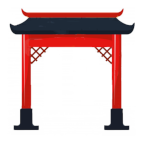| Meaning |

north 北
|
| Explanation |
Two persons sit back-to-back, because they feel cold in the north.
|
Used in these characters:
|
|
北
|
 |
|
JLPT HSK 1 |
|
| north
|
Two persons 丬, 匕 sit back-to-back, because they feel cold: in the north.

|
|
|
|
乘
|
 |
|
JLPT HSK 4 |
|
| to take advantage of, use means (i.e.transportation), multiplication
|
Top: rice plant 禾 (Here: tree 木 with shade-giving canopy 一), middle: north 北 (2 people 丬,匕 sit back-to-back because it is cold in: the north.)
When the two people lean against the shade-giving tree, they: take advantage of it.

|
|
|
|
剩
|
 |
|
JLPT HSK 4 |
|
| to remain, to be left, to have as remainder
|
Left: to use, take advantage of 乘 (When the two people 丬,匕 lean against the shade-giving 一 tree 木, they: are using it.), right: to cut/knife刂
When using a knife, there are always remainders.

|
|
|
|
背
|
 |
|
JLPT HSK 5 |
|
| back, behind, hide, to carry on the shoulder
bēi, bèi
北
肉
 |
|
Top: north 北 (here: backbone || with ribs, or two persons sitting back to back), below: body part 月/肉
The backbone is the body part at the back and suitable to carry.

|
|
|
|
乖
|
 |
|
JLPT HSK 5 |
|
| obedient (of a child), well-behaved, clever, lovable
|
Inside: thousand 千, outside: North 北 (Two persons 丬,匕 sit back-to-back because of the north's cold.)
If 1000 persons are sitting back-to-back, they are obedient children.

|
|
|
|
燕
|
 |
|
JLPT no HSK |
|
| swallow (bird), Yan (state of Zhou)
|
From top: twenty 廿, north 北 (2 people sit back-to-back because of the north's cold.), mouth 口, fire 灬
In (groups of) twenty they come from the north, because of the food (= mouth) and the temperature (=fire): the swallows

|
|
|
|
脊
|
 |
|
JLPT no HSK |
|
| spine, ridge, back
|
This character is seen as variation of back/stature: 背 with two persons 北 sitting back-to-back
'Back-to-back' the persons are sitting with this body part: The spine.

|
|
|
|
冀
|
 |
|
JLPT no HSK |
|
| to hope, wish, (abbr. for Hebei 河北)
|
Top: north 北 (2 people sit back-to-back because it is cold in: the north.), bottom: differ, extraordinary 異 (Put a rice paddy 田 together 共 (with other paddies) and you will see how much they differ.)
(Everyone joins the work) Also on the northern fields we shall work together! That's what I hope for!

|
|
|
|
骥
|
 |
|
JLPT no HSK |
|
| thoroughbred horse, refined and virtuous
|
Слева: лошадь 马/馬 (с гривой 三, четырьмя ногами 灬 и хвостом ㄅ), справа: надеяться, желать 冀 (Все работают вместе:) Даже на севере 北 мы хотим быть вместе 共 на полях 田! Я этого желаю!
Лошадь, которую мы желаем, это: чистокровная лошадь.

|
|
|
| Radicals are shown here that are similar either in appearance or meaning. |  |
|
At the page you get the memory phrases for learning the Chinese Hanzi. If you are learning the Japanese kanji, please follow this link. |
List of the characters |
List of the radicals
|

